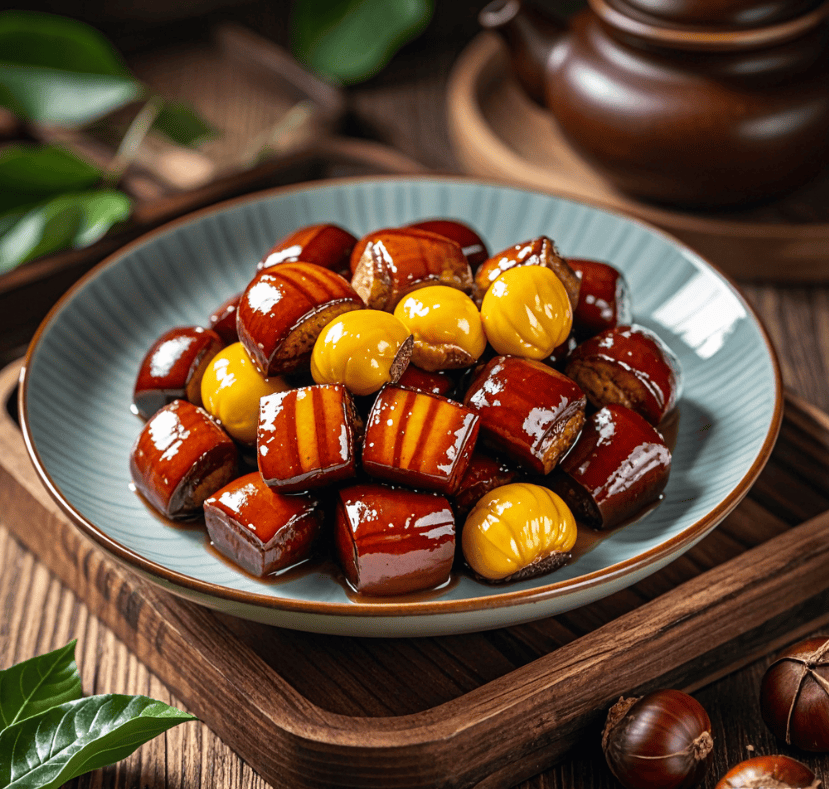Guide: As the saying goes, “nutrition from food is better than that from medicine.” Today, I’m going to recommend a delicious dish passed down from our ancestors—braised pork with chestnuts. It’s not just a delicacy on the table but also a small guardian for our kidneys, affectionately called “kidney-strengthening dish” by many.
1. Braised Pork with Chestnuts: A Legendary Dish for Nourishing the Kidneys
I remember that during autumn and winter in my childhood, my family would always stew a pot of steaming braised pork with chestnuts, and the aroma would waft down the streets, enticing neighborhood kids to gather around. Back then, I didn’t understand; I just thought it was delicious, only to learn as I grew up that this dish hides great knowledge!
Traditional Chinese medicine emphasizes “supplementing form with form and color with color.” Chestnuts are yellow and enter the spleen, which is the foundation of acquired vitality, the source of qi and blood; they are sweet and warming, capable of nourishing the kidneys, strengthening the lower back, and benefiting the spleen and stomach. Looking at the braised pork, high-quality pork belly is selected, with a mix of fat and lean, rich in high-quality protein and fat, nourishing the internal organs, especially the kidneys. The combination of the two is an excellent pairing for kidney nourishment and blood enrichment.
As early as recorded in “Compendium of Materia Medica”: “Chestnuts nourish kidney qi and help endure hunger.” Regarding meat’s nourishing properties, the ancients also stated: “Meat is meant to replenish essence and benefit qi.” Though braised pork with chestnuts isn’t mentioned directly, the combination of the two undoubtedly represents the wisdom of the ancients perfectly interpreted on the modern dining table.
2. Get Hands-On: A Harmony of Taste and Health
-Braised Pork with Chestnuts-
[Ingredients Preparation]
Select 500 grams of pork belly, cut into about 2 cm cubes, 300 grams of fresh chestnuts, shelled and peeled, a few slices of ginger, one green onion cut into sections, cooking wine, dark soy sauce, light soy sauce, rock sugar, salt to taste, a few star anise, cinnamon, and bay leaves (for aroma).
[Cooking Steps]
Blanch to Remove Odor: Place the pork belly in cold water with a few slices of ginger and a small amount of cooking wine, bring to a boil, skim off the foam, and rinse clean. This step is like giving the meat a bath, removing impurities and odor.
Caramelize Sugar: In a pan, add a small amount of oil and melt rock sugar over low heat until it turns reddish-brown; quickly add the pork cubes, stirring to coat each piece evenly with the enticing caramel. This step is critical for achieving the red sheen and rich flavor of braised pork.
Season and Simmer: Add ginger slices, green onion sections, star anise, cinnamon, bay leaves, and pour in dark soy sauce and light soy sauce for color and seasoning, adding enough hot water to cover the meat. Bring to a boil, then reduce to a simmer. At this point, the aroma fills the room, making one drool.
Add Chestnuts: After simmering for about half an hour, add the chestnuts and continue to cook on low heat until the chestnuts are soft and the pork belly is tender. Adjust salt to taste as needed.
Thicken and Serve: When the sauce becomes thick and both the pork and chestnuts reach the best texture, increase the heat to thicken the sauce, then plate and garnish with chopped green onions. A plate of braised pork with chestnuts, rich in color, aroma, and flavor, is ready to serve, instantly increasing appetites.
3. Eating for Health, Enjoying Flavor
[Health Tips]
Chestnuts are great but should not be consumed in excess, especially for those with weak spleens and stomachs, to avoid adding to the gastrointestinal burden.
Braised pork is delicious but has a high fat content, so moderation is advised, particularly for people with high blood pressure or high cholesterol.
Pairing with some leafy greens or…


